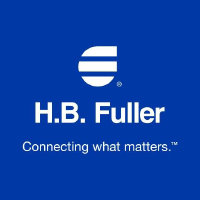
HB Fuller Co
NYSE:FUL


| US |

|
Johnson & Johnson
NYSE:JNJ
|
Pharmaceuticals
|
| US |

|
Berkshire Hathaway Inc
NYSE:BRK.A
|
Financial Services
|
| US |

|
Bank of America Corp
NYSE:BAC
|
Banking
|
| US |

|
Mastercard Inc
NYSE:MA
|
Technology
|
| US |

|
UnitedHealth Group Inc
NYSE:UNH
|
Health Care
|
| US |

|
Exxon Mobil Corp
NYSE:XOM
|
Energy
|
| US |

|
Pfizer Inc
NYSE:PFE
|
Pharmaceuticals
|
| US |

|
Palantir Technologies Inc
NYSE:PLTR
|
Technology
|
| US |

|
Nike Inc
NYSE:NKE
|
Textiles, Apparel & Luxury Goods
|
| US |

|
Visa Inc
NYSE:V
|
Technology
|
| CN |

|
Alibaba Group Holding Ltd
NYSE:BABA
|
Retail
|
| US |

|
3M Co
NYSE:MMM
|
Industrial Conglomerates
|
| US |

|
JPMorgan Chase & Co
NYSE:JPM
|
Banking
|
| US |

|
Coca-Cola Co
NYSE:KO
|
Beverages
|
| US |

|
Walmart Inc
NYSE:WMT
|
Retail
|
| US |

|
Verizon Communications Inc
NYSE:VZ
|
Telecommunication
|
Utilize notes to systematically review your investment decisions. By reflecting on past outcomes, you can discern effective strategies and identify those that underperformed. This continuous feedback loop enables you to adapt and refine your approach, optimizing for future success.
Each note serves as a learning point, offering insights into your decision-making processes. Over time, you'll accumulate a personalized database of knowledge, enhancing your ability to make informed decisions quickly and effectively.
With a comprehensive record of your investment history at your fingertips, you can compare current opportunities against past experiences. This not only bolsters your confidence but also ensures that each decision is grounded in a well-documented rationale.
Do you really want to delete this note?
This action cannot be undone.

| 52 Week Range |
67.96
86.2
|
| Price Target |
|
We'll email you a reminder when the closing price reaches USD.
Choose the stock you wish to monitor with a price alert.

|
Johnson & Johnson
NYSE:JNJ
|
US |

|
Berkshire Hathaway Inc
NYSE:BRK.A
|
US |

|
Bank of America Corp
NYSE:BAC
|
US |

|
Mastercard Inc
NYSE:MA
|
US |

|
UnitedHealth Group Inc
NYSE:UNH
|
US |

|
Exxon Mobil Corp
NYSE:XOM
|
US |

|
Pfizer Inc
NYSE:PFE
|
US |

|
Palantir Technologies Inc
NYSE:PLTR
|
US |

|
Nike Inc
NYSE:NKE
|
US |

|
Visa Inc
NYSE:V
|
US |

|
Alibaba Group Holding Ltd
NYSE:BABA
|
CN |

|
3M Co
NYSE:MMM
|
US |

|
JPMorgan Chase & Co
NYSE:JPM
|
US |

|
Coca-Cola Co
NYSE:KO
|
US |

|
Walmart Inc
NYSE:WMT
|
US |

|
Verizon Communications Inc
NYSE:VZ
|
US |
This alert will be permanently deleted.
 HB Fuller Co
HB Fuller Co
HB Fuller Co
Investor Relations
In the bustling world of specialty chemicals, H.B. Fuller Co. has crafted its legacy as a venerable figure, tracing its roots back to 1887. At its heart, this company thrives on adhesive innovation, developing products that quite literally hold things together across a multitude of industries. From the intricate electronics in your palm to the robust construction materials that shape our cities, H.B. Fuller's adhesive solutions play a silent, yet vital role. The company has honed its expertise in producing adhesive formulas that cater to diverse markets, including packaging, hygiene, construction, and automotive, revealing its keen ability to adapt its offerings to the ever-evolving needs of its global clientele.
What sets H.B. Fuller apart is not just its product diversity, but its commitment to sustainability and innovation. By investing heavily in R&D, they continue to enhance adhesive technology, ensuring it meets the standards of modern efficiency and environmental consciousness. This strategy is reflected in their emphasis on producing adhesives with reduced environmental impact without compromising performance. Their revenue model is built on successfully integrating their adhesive technologies into the manufacturing processes of their business clients worldwide. Each customized solution not only binds components together but also binds H.B. Fuller Co. to a future focused on sustainable growth and the continuous exploration of new applications for their adhesive expertise.

In the bustling world of specialty chemicals, H.B. Fuller Co. has crafted its legacy as a venerable figure, tracing its roots back to 1887. At its heart, this company thrives on adhesive innovation, developing products that quite literally hold things together across a multitude of industries. From the intricate electronics in your palm to the robust construction materials that shape our cities, H.B. Fuller's adhesive solutions play a silent, yet vital role. The company has honed its expertise in producing adhesive formulas that cater to diverse markets, including packaging, hygiene, construction, and automotive, revealing its keen ability to adapt its offerings to the ever-evolving needs of its global clientele.
What sets H.B. Fuller apart is not just its product diversity, but its commitment to sustainability and innovation. By investing heavily in R&D, they continue to enhance adhesive technology, ensuring it meets the standards of modern efficiency and environmental consciousness. This strategy is reflected in their emphasis on producing adhesives with reduced environmental impact without compromising performance. Their revenue model is built on successfully integrating their adhesive technologies into the manufacturing processes of their business clients worldwide. Each customized solution not only binds components together but also binds H.B. Fuller Co. to a future focused on sustainable growth and the continuous exploration of new applications for their adhesive expertise.





























 You don't have any saved screeners yet
You don't have any saved screeners yet
